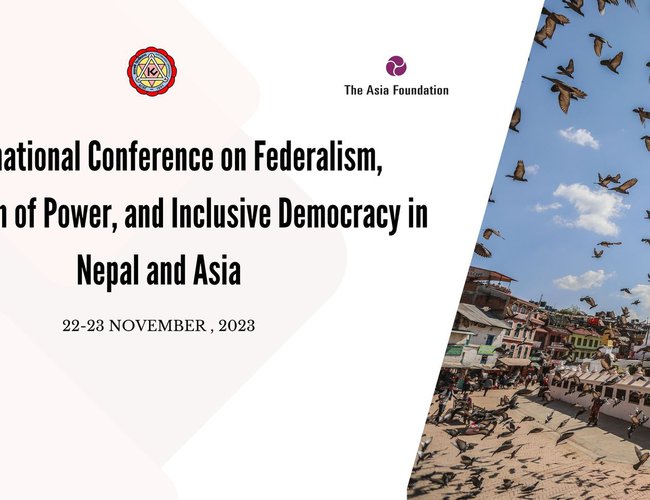
In the Comprehensive Peace Accord signed between the Seven Party Alliance and the Maoists in 22November 2006, the parties committed “to address the problems related to women, Dalit,indigenous people, Janajatis, Madhesi, oppressed, neglected and minority communities andbackward regions by ending discrimination based on class, caste, language, gender, culture, religion,and region.” Over time, the term “proportional representation” became a term, not only for politicalparties in proportion to votes, but also of caste and ethnic groups in proportion to their share of thepopulation.
The electoral system to the House of Representatives (HoR) is a mixed system with 60% electedthrough first-past-the-post (FPTP) and 40% by List proportional representation (PR). Parties winseats in parliament in proportion to their share of the vote. In addition, an elaborate quota systemwas introduced, with fixed shares for Dalit, Janajatis, Khas Arya, Madhesi, Tharu, Muslims andbackward regions. The election law has specified the share for each group, adding up to 100%, whichmeant that also the elite would be guaranteed seats in PR, in addition to the advantage they had inFPTP, and their quota represented a cap on the inclusion of excluded groups. In addition, womenshould have at least 50% in PR and at least 1/3 of the total membership in the HoR.
The quotas for all groups have produced an extraordinary complicated system, which has reducedtransparency of the system, and more importantly, has set limitations to the possibility for achievinggenuine equalities for traditionally discriminated groups. All quota rules reduce the equality ofelection. However, such rules are acceptable if they are designed to create genuine equality forotherwise excluded groups, such as women, Dalits, etc. With rules aimed only at removingdiscrimination, the system could be more transparent, simple, and the voters could see a closerconnection to those elected from PR lists.
Who are the neglected groups who would need a push to be included in the HoR? One answer canbe given by studying which groups win a fair share of the seats when no quotas are applied, such asin the FPTP part of the elections. By comparing the share of seats won by a group with its share in thepopulation, one can conclude that Dalits and Muslims are excluded whereas Khas Arya always winseats far above their share of the population (even if there may be regional differences). WithinJanajatis and Madhesi castes, there are groups, which fare well in elections and groups, which aresystematically excluded. There is a “creamy layer” within the groups doing well, but many do onlyoccasionally win seats. It turns out that the trends are very stable over time, from the 1991 electionsuntil the elections in 2022. Groups representing 46.6% of the population (2021 census) have beenable to win only from 9 to 15 % of the FPTP seats (with the exception of 2008 when they won 22%).
And the reverse: 53.4 % of the population win around 80-90 % of the seats. This indicates that quotarules could be designed to help the excluded groups to win more seats, rather than giving quotas forthe elite. Today, Dalits are supposed to have 13.8% of the PR seats, but they cannot have more thanthat even if they would win only around 1 % of the FPTP seats.
The excluded groups would be Dalits, Muslims, and some Janajatis and some Madhesi castes.There could be several alternatives for the implementation of quotas for excluded. Firstly, thereshould be minimum quotas, not exact quotas, there could also be minimum quotas on the wholemembership of the HoR, such as the female quota of 1/3, and the PR side could be used to top upthe to reach the minimum.
The Constitution of 2015 states in its preamble that we, the sovereign people of Nepal;“[…] resolving to build an egalitarian society based on the proportional inclusive andparticipatory principles in order to ensure economic equality, prosperity and social justice byeliminating discrimination based on class, caste, region, language, religion and gender and allforms of caste based untouchability;… ”
The “proportional inclusive” principle was only implemented for 40 % of the seats in HoR, whereas atargeted quota system could produce more inclusiveness.
The ethnic and caste quotas would hopefully over time show not to be needed to provide inclusiveresults. The quotas should therefore be re-examined at a regular basis, for example every ten years.
There has been criticism of the PR elections because people have felt that those elected from listsare not elected by voters but by parties. Candidates for both races are nominated by parties (unlessindependent) and voters vote for lists with named candidates so both PR and FPTP are directelections. However, the ranking of the lists is not followed strictly. Parties may jump down the listto fill a seat, but from 2015 onwards, they cannot skip a candidate, which fills a quota to chooseanother of the same identity. Still, this may be seen as a less transparent process. If the quota ruleshad been simplified it would be simpler to set up ranked lists, which would work for all results.
Another reform, which could be considered, would be for parties to set up provincial lists instead ofnational lists. Still, the national result would decide how many seats a party would win, but the seatswould be filled from the provincial lists according to the number of votes won by the parties in theprovinces. In this way, the distance from the voters to those elected would be shortened.
(Partial transcript from the author's presentation at the International Conference on Federalism, Devolution of Power, and Inclusive Democracy in Nepal and Asia, hosted by Kathmandu University School of Law on November 22-23, 2023.)













